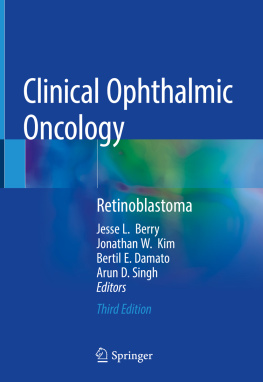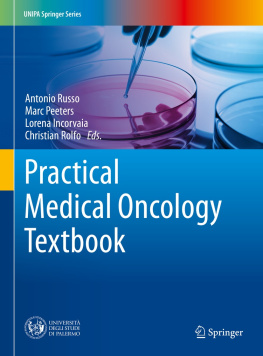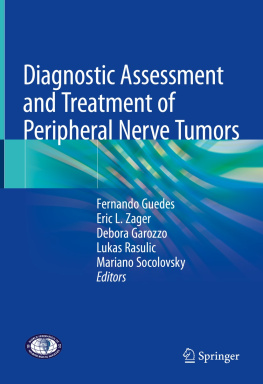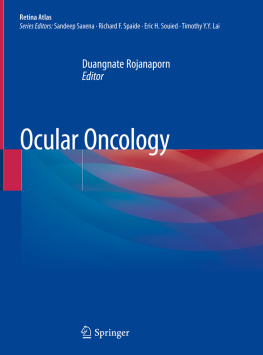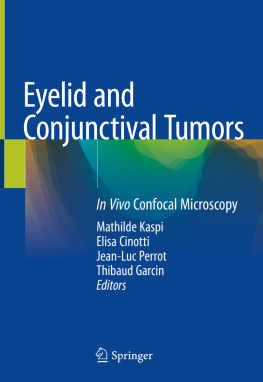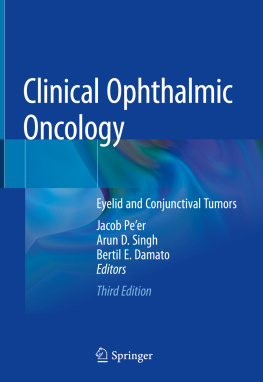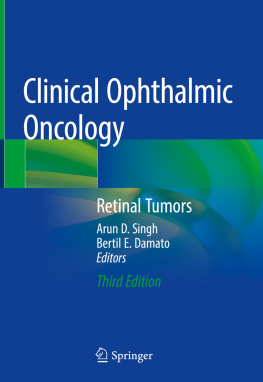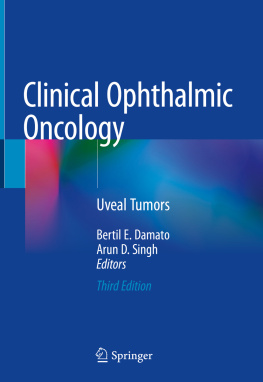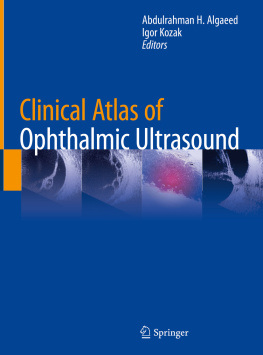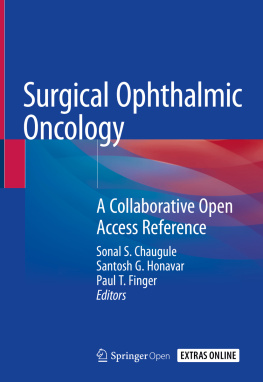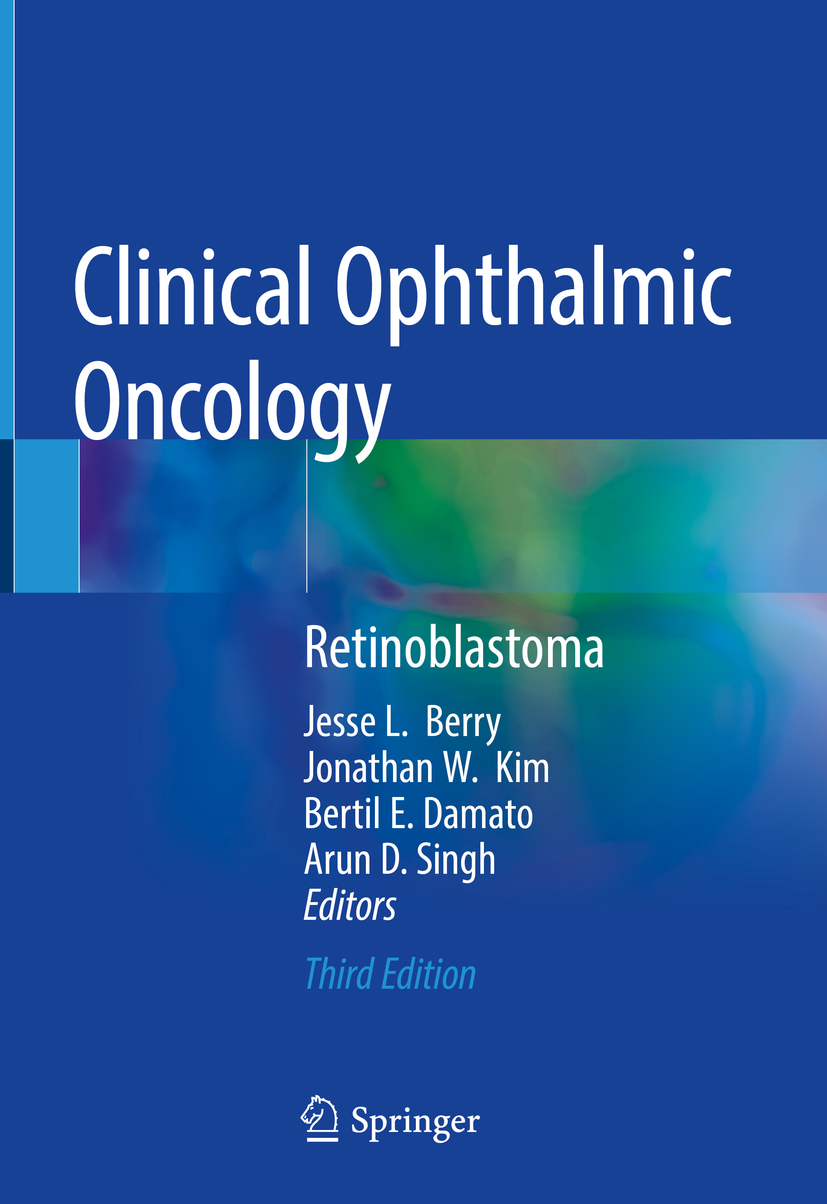Editors
Jesse L. Berry , Jonathan W. Kim , Bertil E. Damato and Arun D. Singh
Clinical Ophthalmic Oncology Retinoblastoma 3rd ed. 2019
Editors
Jesse L. Berry
Associate Professor of Ophthalmology, Childrens Hospital Los Angeles, The USC Roski Eye Institute Keck School of Medicine, Los Angeles, CA, USA
Jonathan W. Kim
Childrens Hospital Los Angeles, The USC Roski Eye Institute, Keck School of Medicine, Los Angeles, CA, USA
Bertil E. Damato
University of Oxford, Nuffield Department of Clinical Neurosciences, John Radcliffe Hospital, Oxford, UK
Arun D. Singh
Department of Ophthalmic Oncology, Cole Eye Institute, Cleveland Clinic, Cleveland, OH, USA
ISBN 978-3-030-11122-9 e-ISBN 978-3-030-11123-6
https://doi.org/10.1007/978-3-030-11123-6
Library of Congress Control Number: 2019934958
Springer Nature Switzerland AG 2019
This work is subject to copyright. All rights are reserved by the Publisher, whether the whole or part of the material is concerned, specifically the rights of translation, reprinting, reuse of illustrations, recitation, broadcasting, reproduction on microfilms or in any other physical way, and transmission or information storage and retrieval, electronic adaptation, computer software, or by similar or dissimilar methodology now known or hereafter developed.
The use of general descriptive names, registered names, trademarks, service marks, etc. in this publication does not imply, even in the absence of a specific statement, that such names are exempt from the relevant protective laws and regulations and therefore free for general use.
The publisher, the authors, and the editors are safe to assume that the advice and information in this book are believed to be true and accurate at the date of publication. Neither the publisher nor the authors or the editors give a warranty, express or implied, with respect to the material contained herein or for any errors or omissions that may have been made. The publisher remains neutral with regard to jurisdictional claims in published maps and institutional affiliations.
This Springer imprint is published by the registered company Springer Nature Switzerland AG.
The registered company address is: Gewerbestrasse 11, 6330 Cham, Switzerland
Preface
Ophthalmic tumors are rare and diverse, so their diagnosis can be quite complex. Treatment usually requires special expertise and equipment and, in many instances, is controversial. The field is advancing rapidly, because of accelerating progress in tumor biology, pharmacology, and instrumentation. Increasingly, the care of patients with an ocular or adnexal tumor is provided by a multidisciplinary team, consisting of ocular oncologists, general oncologists, radiotherapists, pathologists, psychologists, and other specialists.
For all these reasons, we felt that there was a need for the new edition of the textbook providing a balanced view of current clinical practice. Although each section of Clinical Ophthalmic Oncology now represents a standalone volume, each chapter has a similar layout with boxes that highlight the key features, tables that provide comparison, and flow diagrams that outline therapeutic approaches.
The enormous task of editing a multi-author, multivolume textbook could not have been possible without the support and guidance by the staff at Springer: Caitlin Prim, Melanie Zerah, ArulRonika Pathinathan, and Karthik Rajasekar. Michael D. Sova kept the pressure on to meet the production deadlines.
It is our sincere hope that our efforts will meet the high expectation of the readers.
Jesse L. Berry
Jonathan W. Kim
Bertil E. Damato
Arun D. Singh
Los Angeles, CA, USA Los Angeles, CA, USA Oxford, UK Cleveland, OH, USA
Acknowledgments
I want to acknowledge my friend and mentor, Linn Murphree; my grandmother, Jeannette, for always believing in me; my husband, Paul, and our growing family. (JB)
I want to acknowledge and thank my teachers, A. Linn Murphree, Bertil Damato, and David Abramson, for their wonderful mentorship over the years. I would also like to thank my parents, Heja and Jinku, for inspiring a young boy to become a physician. To Diana and Devin, I dedicate all of my work here and forever to both of you. (JWK)
To my family, Frankanne, Erika, Stephen, and Anna. (BED)
To my parents who educated me beyond their means, my wife Annapurna, and my children, Nakul and Rahul, who make all my efforts worthwhile. (ADS)
A. Linn Murphree, MD, Professor of Ophthalmology and Pediatrics at the Keck School of Medicine, University of Southern California (USC), and former Director of the USC Ocular Oncology Service and the Childrens Hospital Los Angeles (CHLA) Retinoblastoma Program
Following his training as a Fulbright Fellow in Human Genetics at the University of Copenhagen, Dr. Murphree began his medical training at Baylor College of Medicine with an interest in human genetics. He discovered a passion for both ophthalmology and pediatrics in medical school and subsequently combined those three interests by focusing his career on ophthalmic genetic diseases including retinoblastoma.
Dr. Murphree assumed the position of Division Head, Pediatric Ophthalmology, at CHLA upon completion of his fellowship in pediatric ophthalmology at Johns Hopkins Hospital. With his first NIH grant, he was one of the pioneers in discovering the location of the retinoblastoma gene on chromosome 13 by performing detailed deletion mapping. Subsequently, he developed a clinical referral practice focused on ocular oncology and developed the largest retinoblastoma referral center in the western USA.
In addition to the discovery of the retinoblastoma gene, Dr. Murphrees contributions to the field of pediatric ocular oncology are numerous and groundbreaking. In his clinical practice, Dr. Murphree recognized an unmet need for a wide-field retinal camera to document the intraocular findings associated with retinoblastoma. He recruited a team of engineers and collaborated with optical engineers in private industry to develop the RetCam, which is the most widely used retinal camera in the world to document pediatric retinal abnormalities. Dr. Murphrees work on systemic chemotherapy in the 1990s caused a paradigm shift in the treatment of intraocular retinoblastoma away from enucleation and external beam radiation. Dr. Murphree also created the International Classification system for retinoblastoma, which is still the most popular method for diagnosing retinoblastoma for clinicians worldwide. He is the author or coauthor of more than 70 major papers on retinoblastoma genetics and treatment. Dr. Murphrees work over four decades revolutionized the field of retinoblastoma and improved the lives of countless children afflicted with retinoblastoma.
Dr. Murphree was the former editor of the Retinoblastoma volume of Clinical Ophthalmic Oncology , and we are indebted to him for his mentorship during the writing of this current edition. He is universally respected in the field of ocular oncology for his ingenuity, expertise, kindness, and generous spirit. As the current editors of the

